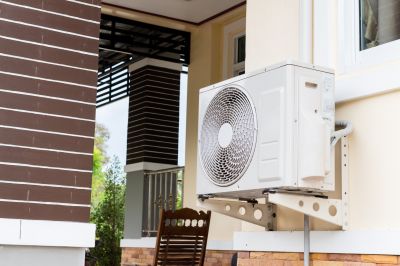Leading Products For Central AC Installations To Enhance Performance
Explore top-rated equipment designed to ensure efficient and reliable central air conditioning setups for any space.
 Installing a central air conditioning system involves a variety of components designed to ensure efficient and reliable cooling throughout a building. From the initial planning stages to final installation, selecting the right products can influence the system's performance and longevity. Essential elements include ductwork, thermostats, air handlers, and various control devices, each playing a vital role in delivering consistent comfort. Properly chosen and installed components can help optimize airflow, maintain temperature stability, and reduce energy consumption.
Installing a central air conditioning system involves a variety of components designed to ensure efficient and reliable cooling throughout a building. From the initial planning stages to final installation, selecting the right products can influence the system's performance and longevity. Essential elements include ductwork, thermostats, air handlers, and various control devices, each playing a vital role in delivering consistent comfort. Properly chosen and installed components can help optimize airflow, maintain temperature stability, and reduce energy consumption.
Top Overall Option
Universal Central AC Duct Kit
A versatile and comprehensive ducting solution designed to fit a wide range of central air conditioning systems. It includes insulated ducts, connectors, and vent registers, making it suitable for various installation scenarios. The kit emphasizes ease of assembly and durability, helping ensure efficient airflow throughout the building. Its adaptable design allows for customization to meet specific space requirements, supporting a smooth installation process.
Types of Products For Central Ac Installations
Flexible Ducts
Flexible ducts are used to connect various components and navigate around obstacles, offering ease of installation and adaptability.
Rigid Metal Ducts
Rigid metal ducts provide sturdy and long-lasting airflow pathways, often used in permanent installations for their durability.
Insulated Ducts
Insulated ducts help maintain temperature and reduce noise, ideal for energy efficiency and comfort.
Thermostats
Thermostats regulate the temperature by controlling the system's operation, offering programmable and smart features.
Air Handlers
Air handlers circulate conditioned air and contain filters and fans, essential for system operation.
Condensers
Condensers expel heat from the refrigerant, playing a critical role in the cooling cycle.
Refrigerant Lines
Refrigerant lines connect the indoor and outdoor units, facilitating the flow of refrigerant.
Drain Pans
Drain pans collect condensate and help prevent water damage or mold growth.
Air Filters
Filters trap dust and debris, improving indoor air quality and system efficiency.
Vents and Registers
Vents and registers distribute conditioned air into individual rooms and allow for airflow control.
Control Valves
Control valves regulate refrigerant flow, ensuring optimal system performance.
Zone Control Systems
Zone control systems enable independent temperature control in different areas of a building.
Insulation Materials
Insulation helps prevent energy loss and noise transmission within ductwork and components.
Electrical Components
Electrical components include wiring, relays, and circuit boards necessary for system operation.
Mounting Brackets
Mounting brackets secure components like condensers and air handlers in place.
Popular Choices
Flexible ducts are favored for their ease of installation and adaptability in tight spaces.
Programmable thermostats are trending for their convenience in scheduling temperature settings.
High-efficiency air filters are popular for improving indoor air quality and system performance.
Outdoor condensers are essential components that often attract attention due to their critical role.
Air handlers with variable speed fans are trending for their ability to fine-tune airflow.
Durable drain pans are commonly chosen to prevent water damage and mold growth.
Adjustable vents and registers are popular for controlling airflow in individual rooms.
Reliable refrigerant line sets are frequently selected for their compatibility and ease of installation.
Zone control systems are gaining popularity for customizable comfort in multi-zone setups.
Insulated ducts are favored for reducing energy loss and noise transmission.
Reliable electrical components are critical for safe and consistent system operation.
Secure mounting brackets are popular for ensuring stable installation of outdoor units.
The process begins with assessing the space and understanding the specific cooling needs. This assessment guides the selection of compatible products that can seamlessly integrate into the existing or new infrastructure. High-quality ductwork, for instance, ensures minimal air loss and noise, while reliable thermostats provide precise temperature control. Air handlers and condensers must be appropriately rated for the space to avoid overworking the system, which can lead to increased wear and tear.
Installation products also include safety and maintenance accessories such as filters, drain pans, and insulation materials. These components help prevent issues like mold growth, refrigerant leaks, and inefficient operation. When choosing products, it is important to consider compatibility with the overall system, ease of installation, and long-term durability. Consulting with professionals and selecting reputable brands can contribute to a smoother installation process and better system performance over time.
Overall, a well-planned selection of products for central AC installation can support a comfortable indoor environment while potentially reducing operational costs. Whether upgrading an existing system or installing a new one, understanding the variety of available products and their functions can help homeowners and contractors make informed decisions. Proper installation and maintenance are key to maximizing the benefits of a central air conditioning system, ensuring it operates efficiently and reliably for years to come.
Key Buying Considerations
- Compatibility with existing or planned central AC system components
- Material durability and resistance to corrosion or damage
- Ease of installation and availability of professional support
- Energy efficiency ratings and potential impact on operational costs
- Size and capacity appropriate for the space to ensure effective cooling
- Compatibility with smart home or programmable controls
- Noise levels during operation, especially for ductwork and air handlers
- Maintenance requirements and ease of access for cleaning or repairs
- Quality of seals and insulation to prevent air leaks and energy loss
- Safety features such as secure connections and proper electrical grounding
- Availability of replacement parts and long-term support
- Compliance with local building codes and standards
- Flexibility for future upgrades or system expansions
- Cost considerations balanced with quality and performance
- Brand reputation and customer support services
